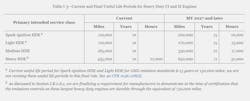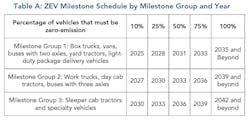EPA poised to grant California more rigid emissions rule than rest of nation: report
The U.S. Environmental Protection Agency plans to grant California waivers to enforce the strictest emissions rules in the nation, according to a newspaper report that cited three unnamed sources familiar with the Biden administration's intentions. Because other states have committed to following California's lead on air regulation, it could have supply chain ramifications across the U.S., according to American Trucking Associations' leader.
"Our industry hopes these reports aren't true," Chris Spear, American Trucking Associations' president and CEO, said in response to a Washington Post article published this week. "We have worked tirelessly with EPA on aggressive, achievable timelines for emissions reductions over decades."
The potential California rules target diesel-powered trucks, which the state says cause about a third of the state's air pollution. Spear, however, pointed out that trucks hauling freight across the U.S. are already much cleaner than they used to be. More than 70% of U.S. freight is moved by truck, according to ATA.
"A truck in 1988 emitted as much as 60 trucks today—a more than 98% reduction—and we're committed to the path to zero," Spear said.
Pushing the 'unachievable' on trucking
Spear stressed the trucking industry's commitment to decarbonization during a speech at ATA's Technology & Maintenance Council annual meeting in Orlando last month. But the ATA leader said that needs to be done "responsibly and realistically."
"The next decade could, if we do not stand up as one and speak rationally, reshape our industry and, as a result, our economy," Spear told TMC attendees on Feb. 27. "The timelines and targets that CARB and this EPA are putting forward is simply unachievable."
See also: OEMs need restraint as fleets figure out alt-fuels
That speech came a month after the EPA finalized its new heavy-duty engines and vehicles rule. The agency called it "the strongest-ever national clean air standard to cut smog- and soot-forming emissions from heavy-duty trucks." The government said its new rules, which are in the final review days, are "80% stronger than current standards."
The new national final rule would lower emissions of NOx and other air pollutants beginning with model year 2027 engines and equipment, according to EPA. Emissions reduction requirements would increase over time as additional cleaner vehicles enter the market.
The new rules are the first part of the EPA's three-step Clean Trucks Plan. The following steps include a proposed Phase 3 greenhouse gas standards for heavy-duty vehicles beginning in model year 2027 and multipollutant standards for light- and medium-duty vehicles starting with that same model year.
When the strict standards were announced in December, Spear noted that while the onus is on OEMs to reduce potential emissions, fleets "ultimately determine their success or failure."
The Truck and Engine Manufacturers Association, which represents OEMs and engine builders, said the EPA rules would be challenging to implement as quickly as the government is pushing.
"Our members are fully committed to working with the EPA and other stakeholders for its successful implementation," Jed R. Mandel, the association president, said when EPA unveiled its new emissions rules. "Ultimately, the success or failure of this rule hinges on the willingness and ability of trucking fleets to invest in purchasing the new technology to replace their older, higher-emitting vehicles."
ATA: Emissions patchwork won't work
According to the Washington Post's sources, the EPA planned to announce the waivers earlier this month, but complications delayed it. According to the Post, the California Air Resources Board, known as CARB, asked the EPA for more time to review its tailpipe pollution rule. Neither would say when they expect to make a formal announcement.
In response to the Post report, Spear said ATA is concerned about the potential disruption to trucking and national supply chains if the EPA allows different emissions standards in other states. Singling out the Golden State, he said: "We hope EPA and the California Air Resources Board will ultimately agree to a uniform, single standard that best achieves our nation's environmental goals."
Massachusetts, New Jersey, New York, Oregon, Vermont, and Washington have also copied California's Advanced Clean Truck rule. Those states would also need EPA waivers to enforce stricter regulations, according to the Clean Air Act.
CARB, the body that oversees California air regulations, wants to ban medium- and heavy-duty diesel and gasoline vehicles by 2040—while limiting how many non-zero-emission vehicles fleets can purchase in the years leading up to the cutoff. Its initial truck rule, finalized in 2021, begins with model year 2024 equipment in California—three years earlier than the EPA's new nationwide standards.
See also: GOP senators seek to overturn EPA's new truck emissions standards
"If the reports are, in fact, accurate, let us remind you that this isn't the United States of California," Spear said this week. "As we learned in the pandemic, the supply chain can be a fragile thing—and its integrity must be preserved at the national level. This decision has little to do with improving the environment and everything to do with placating the far left of the environmental lobby without regard for the hard-working men and women of our industry or our country who will be left to implement California's vision for America."
Matthew Spears, executive director for global regulatory affairs at Cummins, said that fleets should plan for the law to be implemented. Speaking about the California rules during an ATA conference last fall in San Diego, he anticipates legal challenges could hold up the implementation if EPA grants California a waiver.
"They really did take pretty much every element of their regulations and make them tighter and more stringent—more stringent NOx standards, more stringent PMs (particulate matter) standards, longer useful life, longer warranty, more comprehensive in-use test procedures," Spears said last year. "All of these are ultimately directed at the engine manufacturer, who certifies and assures compliance for the emission standards for the tailpipe emissions that come out of that product."
ATA's Spear said the potential "patchwork" of state and federal regulations shows that regulators have "no grasp on the real costs of designing, building, manufacturing, and operating the trucks that deliver their groceries, clothes, and goods, but they will certainly feel the pain when these fanciful projections lead to catastrophic disruptions well beyond California's borders."
About the Author
Josh Fisher
Editor-in-Chief
Editor-in-Chief Josh Fisher has been with FleetOwner since 2017. He covers everything from modern fleet management to operational efficiency, artificial intelligence, autonomous trucking, alternative fuels and powertrains, regulations, and emerging transportation technology. Based in Maryland, he writes the Lane Shift Ahead column about the changing North American transportation landscape.




